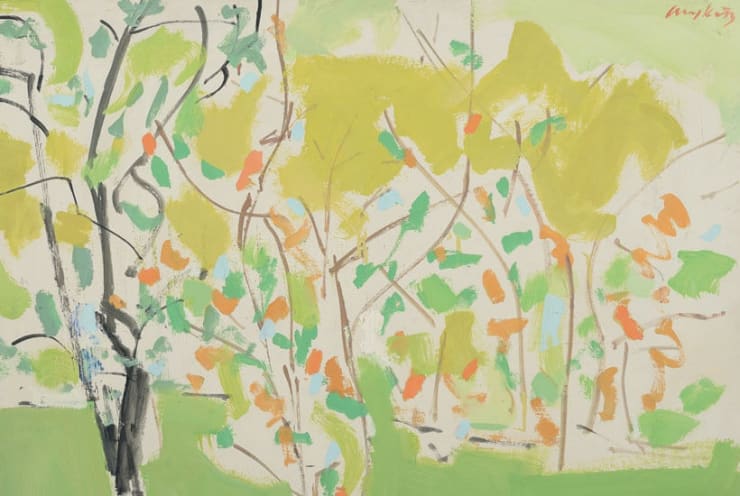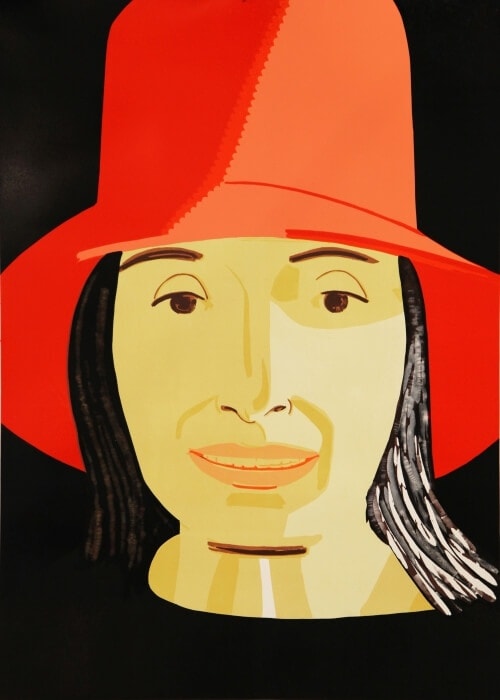Ada was working as a research biologist at Sloan Kettering in the fall of 1957. She had recently returned from studying tumor genetics in Milan on a Fulbright when she walked into the Tanager Gallery for the opening night of an art exhibit. Alex Katz’s art was on the walls. The two met. She still maintains she was shy about visiting galleries. He’s adamant she was already a legend in the New York City art-world.
The two were married in February of 1958. Katz has now painted his wife and muse more than 200 times, and he isn’t done painting at age ninety-one. His ninety-second birthday will be at the end of July, and he still has a tenacity and strength that’s easy to catch in his eyes.
Alex Katz graduated from Cooper Union in 1949 where he received formal training in modern art theory and technique under Morris Kantor. He is highly competitive by nature, and his fierce drive and passion are noticeable in his interviews. In his words, “At Cooper, I went from someone who was basically incompetent to being the best painter in the school.” This ambition and fierce independence would lead him into new styles in art and to the development of a distinct artistic voice.
It was like feeling lust for the first time.
The summers following brought him to Skowhegan in rural Maine where he developed techniques on landscape painting and direct painting—immediately putting down what one sees on canvas. Direct painting coincided with Katz’s artistic motivation, “To paint what’s in front of you.” The school would bus their students out to the Maine countryside, and the students would paint in the open-air. Talking about his experience of direct painting, “It was like feeling lust for the first time.” For Katz, painting is an instinctual drive. Skowhegan was known at the time as a provincial school, and Cooper Union was the very center of the modern art world, but Katz was incorporating information from both worlds.
Abstract Expressionism and Realism were the two dominant trends in art in the 1950’s, but Katz was seeking an artistic language of his own. He wanted to bridge American abstract painting with the technique of the great European artists. He wanted a “big technique” like the masters, and he knew the only way to get there would cost him time. He spent ten years in flats with no hot water, borrowing paint from a friend who owned an art store.
His education in both Abstract Expressionism and Realism came to a head in the late 1950’s. He knew he was a figurative painter, but he was torn between the two dominant trends within society and within his education. His competitive and idiosyncratic personality was pushing him towards different adventures. During this pivotal point in his life, he destroyed over 1000 of his prints that he felt inadequately expressed his perspective. It was during this period in his life when he stumbled into Ada, who became the subject he would paint more than anyone or anything else.
After meeting Ada his focus turned towards portraiture and what he would term “specific” portraits. Traveling home on the subways, he would collect material, studying the faces, the colors of strangers’ clothes. During this time his paintings became larger. He scaled up to canvases as large as nine-and-a-half-feet wide by six-and-a-half-feet high. To paint on this scale he employed a technique from the Renaissance, pouncing, which he still uses today to produce his larger works. In pouncing one draws the image with small pinholes on a large brown paper, and dry pigment is then pushed through the pinholes to leave an outline.
I’m not a pop artist …
Katz says, “I’m not a pop artist, and people can’t see my work as realistic, either.” Pop art found inspiration in commercialized objects while the realistic schools would attempt to copy experience directly. Katz began to adopt some of the techniques of Pop art, especially in the use of large flat areas of color, but always found a real subject. His works translate well in prints, and feel at home enlarged to cover walls. But he had no desire to make Campbell’s soup or Marilyn Monroe the center of his focus, instead he returned over and over to the woods and coast of Maine, and his wife and muse, Ada.
Please contact us if you would like more information about Alex Katz’s prints available at VFA.
www.alexkatz.com/bibliography/selected_articles_and_reviews/
Alex_Katzs_Subway_Drawings_Give_a_Glimpse_of_1940s_New_York-Felsenthal_Julia-Vogue
www.artsy.net/article/artsy-editorial-alex-katz-on-faces-flowers-and-saying-no
www.newyorker.com/magazine/2018/08/27/alex-katzs-life-in-art
www.youtube.com/watch?v=_IZSX1vkhrU&t=2902s
www.nytimes.com/2006/08/27/style/tmagazine/painted-lady.html





